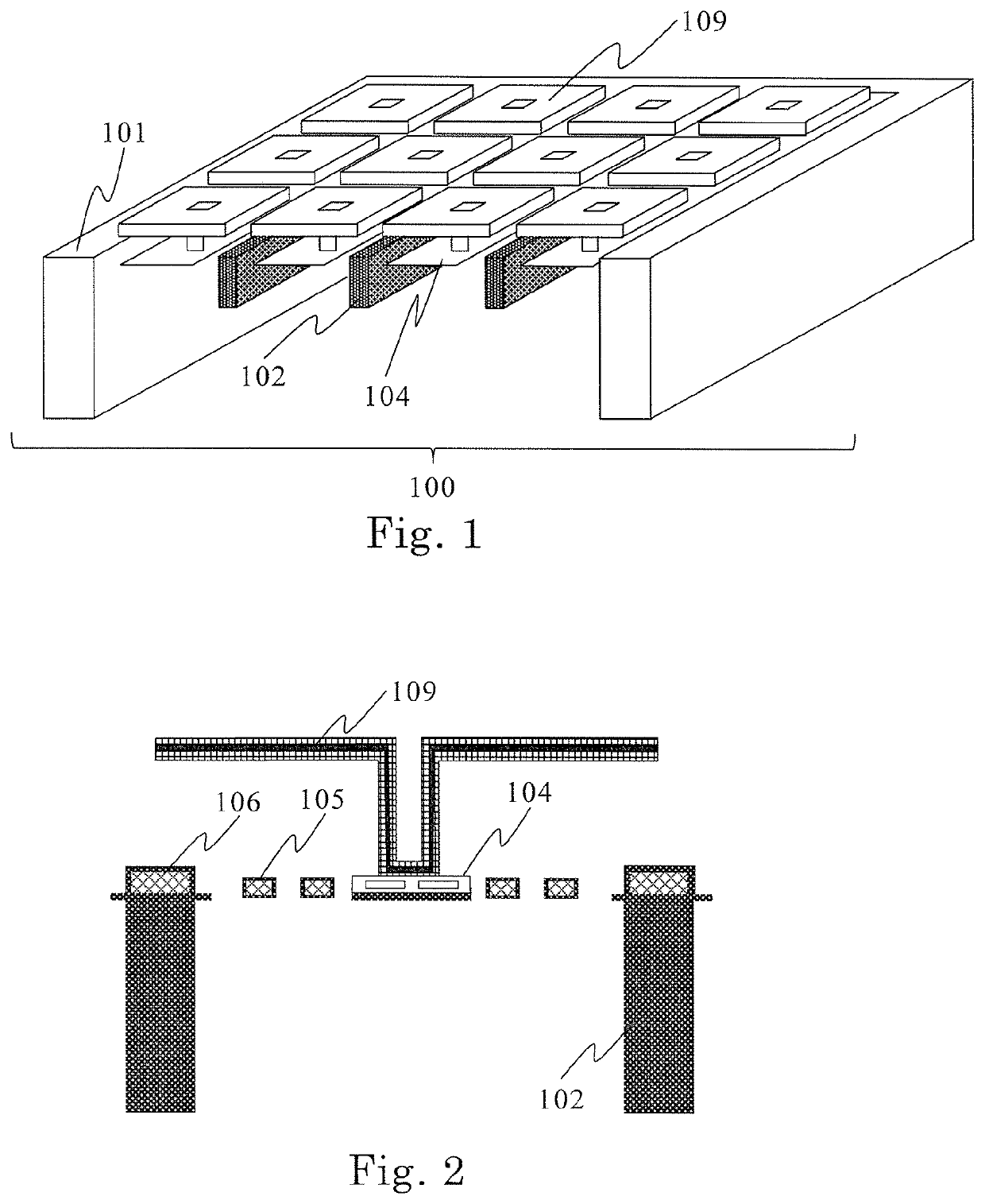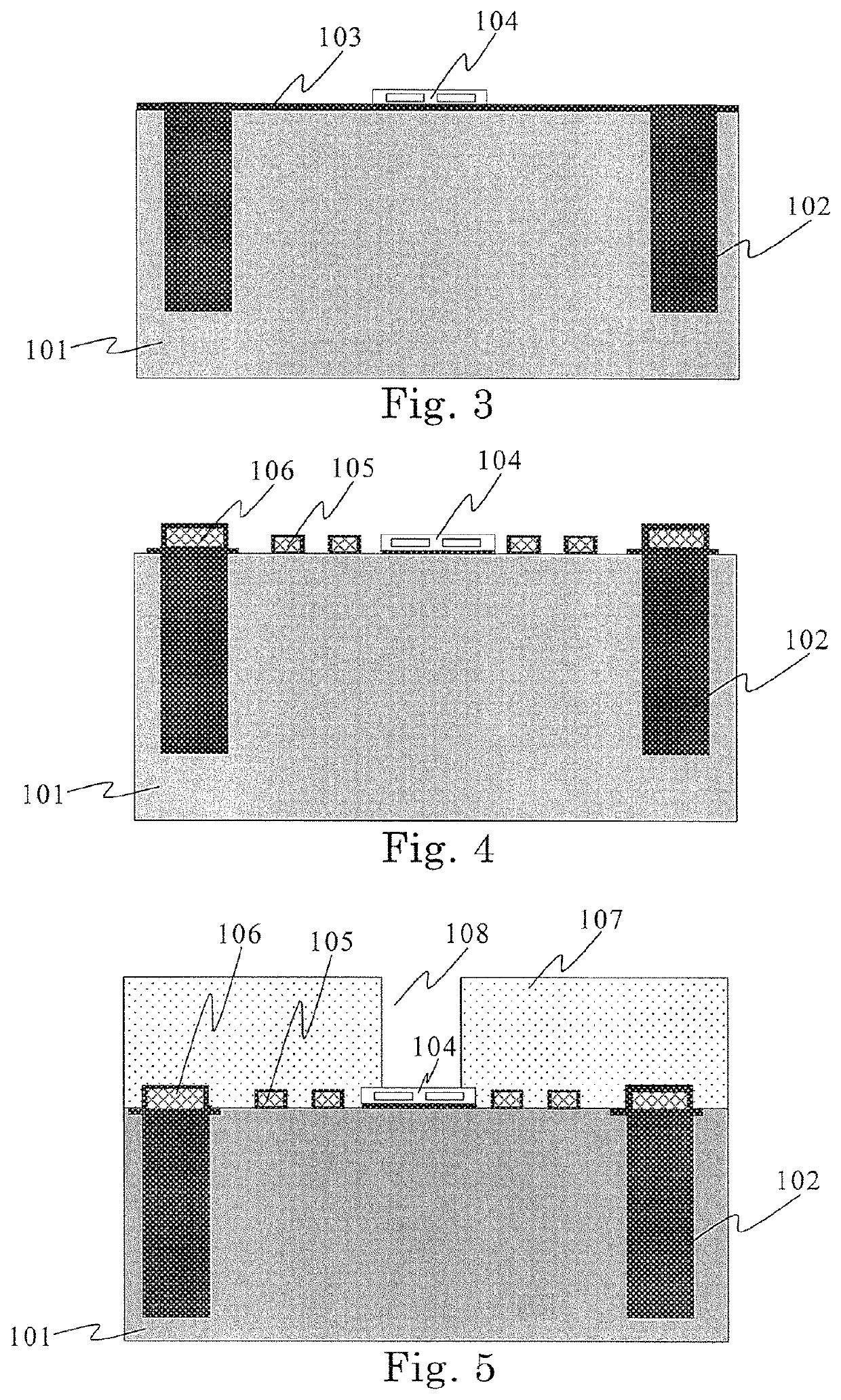Thermal infrared detector and manufacturing method for thermal infrared detector
a technology of thermal infrared detector and manufacturing method, which is applied in the direction of optical radiation measurement, pyrometry using electric radation detectors, instruments, etc., can solve the problems of difficult to improve the sensitivity, the aperture of the sensor element decreases, and the character deteriorates dramatically, so as to improve the detection sensitivity, reduce the thermal time constant, and increase the aperture
- Summary
- Abstract
- Description
- Claims
- Application Information
AI Technical Summary
Benefits of technology
Problems solved by technology
Method used
Image
Examples
first embodiment
[0060]FIG. 1 is a bird's-eye view showing a thermal infrared detector according to a first embodiment of this invention, and FIG. 2 is a sectional view of the thermal infrared detector according to the first embodiment of this invention. A thermal infrared detector 100 shown in FIGS. 1 and 2 is configured to include a substrate 101, a trench structure 102, a sensor element 104, a heat insulation support leg 105, a wire 106, and an infrared ray absorption structure 109.
[0061]In the thermal infrared detector 100 according to the first embodiment, heat insulation hollowing processing is performed without providing an etching hole in the infrared ray absorption structure 109. The thermal infrared detector 100 therefore has a larger aperture than the thermal infrared detector described in Japanese Patent No. 4224949, and as a result, the sensitivity of the thermal infrared detector can be improved.
[0062]Moreover, the trench structures 102 provided between the sensor elements remain conne...
second embodiment
[0082]In a second embodiment of this invention, a thermal infrared detector in which a thermal resistance of the wire 106 for connecting the sensor element to the peripheral circuit can be reduced, enabling a reduction in a thermal time constant, by embedding a high thermal conductivity material 202 in a trench structure 203 will be described.
[0083]Processes for manufacturing the thermal infrared detector according to the second embodiment will be described in sequence using FIGS. 11 to 18. FIGS. 11 to 18 are views showing a sequence of processes for manufacturing the thermal infrared detector according to the second embodiment of this invention.
[0084]Note that FIGS. 13 to 18 show similar processes to the first embodiment, and therefore detailed description thereof has been omitted. Accordingly, in the second embodiment described below, only structures that are unique to the second embodiment and effects derived therefrom will be described, while description of other structures that...
third embodiment
[0094]In a third embodiment of this invention, a thermal infrared detector in which an infrared ray absorbing film is formed additionally on the rear surface side of the sensor element will be described.
[0095]Newly added processes among processes for manufacturing the thermal infrared detector according to the third embodiment will be described in sequence below using FIGS. 19 and 20. FIGS. 19 and 20 are views showing a sequence of processes for manufacturing the thermal infrared detector according to the third embodiment of this invention.
[0096]As shown in FIG. 19, following the process shown in FIG. 8 of the first embodiment or the process shown in FIG. 16 of the second embodiment, an infrared ray absorbing film 301 is formed on a rear surface of a wafer from vanadium, titanium, chrome, a Co-based compound, and a nitride or oxide thereof using a CVD method or the like.
[0097]Next, the infrared ray absorbing film 301 is removed from all regions apart from the region of the sensor el...
PUM
| Property | Measurement | Unit |
|---|---|---|
| detectable wavelength | aaaaa | aaaaa |
| detectable wavelength | aaaaa | aaaaa |
| temperature | aaaaa | aaaaa |
Abstract
Description
Claims
Application Information
 Login to View More
Login to View More - R&D
- Intellectual Property
- Life Sciences
- Materials
- Tech Scout
- Unparalleled Data Quality
- Higher Quality Content
- 60% Fewer Hallucinations
Browse by: Latest US Patents, China's latest patents, Technical Efficacy Thesaurus, Application Domain, Technology Topic, Popular Technical Reports.
© 2025 PatSnap. All rights reserved.Legal|Privacy policy|Modern Slavery Act Transparency Statement|Sitemap|About US| Contact US: help@patsnap.com



